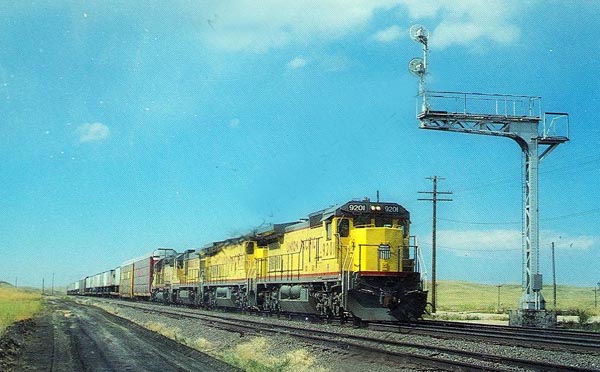
Freight Train near Borie, Wyoming
On October 30, 1970, Congress passed the Rail Passenger Service Act of 1970, the purpose of which was allegedly to provide "fast and comfortable trasportation between crowed urban areas and other areas of the
country. The Act fell woefully short of its promise. Instead of "public convenience," it instead provided in Wyoming inconvenience and a slow, lingering death of
railroad passenger service. Except in the Northeast Corridor connecting the large cites of the northeast to Washington, the service loses money measured by the bilion. After taking over the passenger service,
Amtrac cancelled service east of Cheyenne. The sheds which protected passengers from rain and snow while boarding
trains were removed. Trains to Denver were routed over the Carr-Borie Cutoff west of Cheyenne.
In 1979,Amtrak announced that passenger service was being moved to a new railway station to be known as "West Cheyenne" at Borie. At the time,
there was not much of anything at Borie. The post office had closed in 1901. With the construction of the Borie Cutoff in 1908, there was subsequently constructed
a Dispatch Tower. It too had disappeared by the time of the anouncement. It had been the site of a
railroad Section House and a siding, but nothings more. See 1893 Annual Report of the United States commissioner of Railroads, p. 110..
Early guides to the Lincoln Highway indicated that radiator water was available at Borie. About 1908, early Cheyenne photographer J. E. Stimson ventured out to Borie in his
motor car.
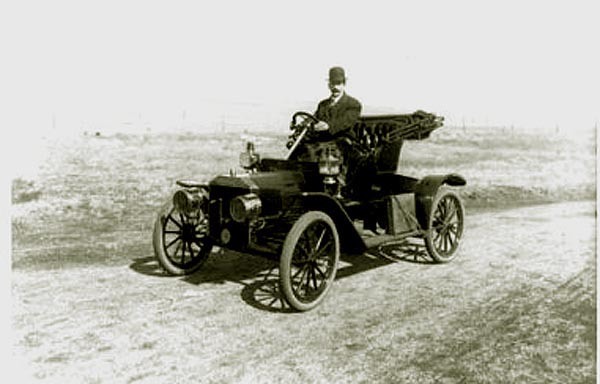
J.E. Stimson near Borie, 1908.
Stimson apparently did not see much of anything other than a switch for the cutoff and a signal tower.
Borie was named after an early dispatcher, Andy Borie. He later rose in the ranks, but perhaps to remind him of his early humble beginnings,
the siding continued to bear his name. Except for two train wrecks arising out of the steepness of the grade on Sherman Hill, the theft of a eleven batteries from a metal building
on July 11, 1971, see Oldham v. State of Wyoming, 534 P. 2d 107 (1975). and the construction of the cut-off in
1908, very little occurred in Borie until the construction of the new railway station in 1970.
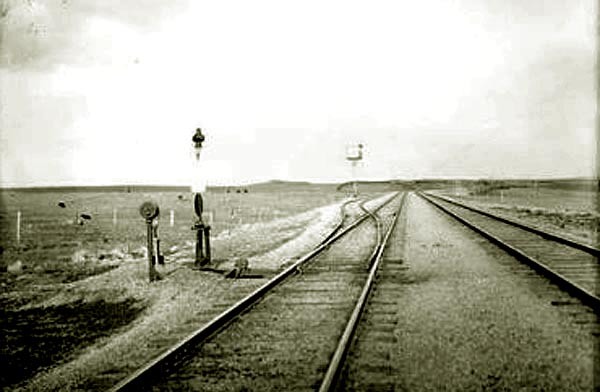
Borie Siding, approx. 1908. Photo by J.E. Stimson.
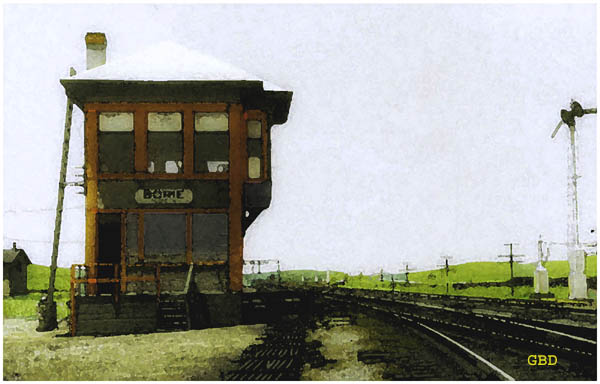
Borie Dispatch Tower, approx. 1952
The beginnings and the end of passenger stations at Borie can find their roots in 1898. Between 1898 and 1902, the Union Pacific
constructed major improvements designed to reduce the grades on Sherman Hill. The improvement included construction of new grades and a tunnel.
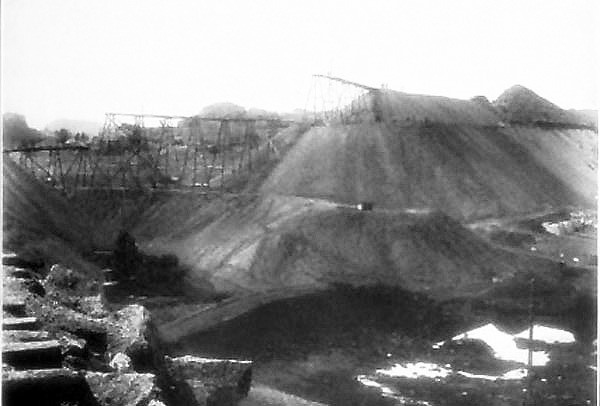
Railroad Construction Sherman Hill, 1902.
The pyramid shaped hill at the extreme right of the photo he pyramid shaped hill beyond the large hill on which work is being done was named by railway workers "Spion Kop" after a hill in Natal, South Africa. Spion Kop was the center of British efforts to relieve
the seige of Ladysmith during the Second Boer War. Another hill near Hanna, Wyoming, bears the same name
as does a hill in Montana. British plans called for taking the hill which would then with big naval guns would command the
valley below and thus relieve the seige. After a two day battle British troops led by Col. Alex Thorneycroft managed to seize the top of the hill.
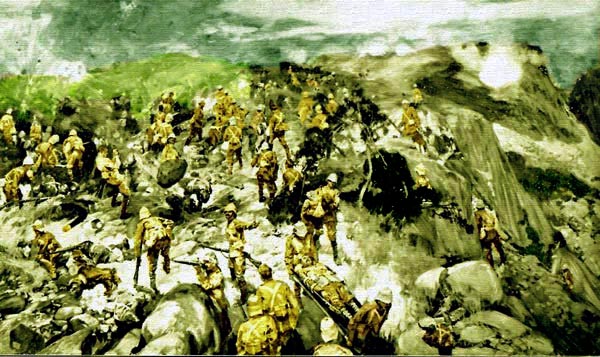
Col. Thornycroft attaining the summit of Spion Kop.
After capturing the hill top, Thorneycroft decided not to retain the hill and withdrew allowing otherwise retreating Boers to retake the hill. Thorneycroft thus managed to
wrest defeat and disaster out of the jaws of victory. One author, Ron Lock, called it the "Hill of Squandered Valor" Casement Publishers and Book Distributors, LLC, 2011.
The result was that the commanding general Sir Redvers Buller was relieved of command. Sir Redvers, after Spion Kop and other defeats, became known amongst his troops as
"Reverse Buller." His successor was Frederick, Lord Roberts. Some question the correct pronounciation of Spion Kop. Liverpuddlians pronounce it Spy-on Kop. In South Africa it is pronounced
Spee-on kop.
Between 1917 and 1919 more improvements were made to the grades and tracks near Dale Creek and Sherman Hill. Those included double-tracking and doubling the tunnels under Sherman
Hill.

Excavation for double-tracking at East Portal Sherman Hill Tunnels, 1918.
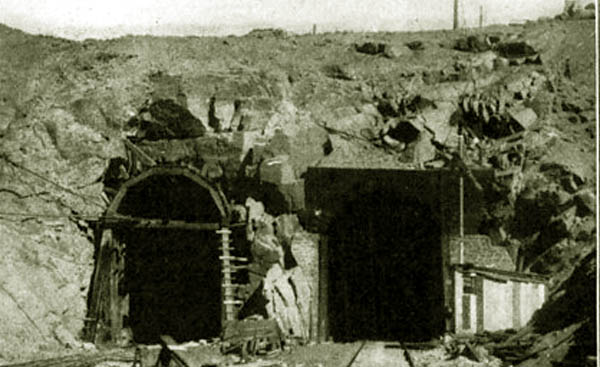
West Portals Sherman Hill Tunnels, 1918.
On October 30, 1970, Congress passed the Rail Passenger Service Act of 1970, the purpose of which was allegedly to provide "fast and comfortable trasportation between crowed urban areas and other areas of the
country. The Act fell woefully short of its promise. Instead of "public convenience," it instead provided in Wyoming inconvenience and a slow, lingering death of
railroad passenger service. Except in the Northeast Corridor connecting the large cites of the northeast to Washington, the service loses money measured by the bilion. After taking over the passenger service,
Amtrac cancelled service east of Cheyenne. The sheds which protected passengers from rain and snow while boarding
trains were removed. Trains to Denver were routed over the Carr-Borie Cutoff west of Cheyenne. The cutoff had been constructed in
1908 to shorten freight traffic from the West Coast to Denver. In its planning, Amtrak apparently overlooked that there was no convenient way of turning trains around in Cheyenne. There was no wye which is the usual method of turning trains around.
To use the Borie Cutoff for trains coming into Cheyenne from the west, it would be necessary to back the train westward ten miles to Borie or use the round house table to turn the locomotive and then connect it to the other end of the train, an expensive and
time consuming process. Thus, in October 1979 service was moved to a new station at Borie ten miles to the west of Cheyenne. The new station did not match in
magnificance the older station. It looked for all the world like a corregated metal storage building that one would purchase at a building
supply house.
Although described by officials in Washington, with not a little exageration, as a "suburb of Cheyenne," see Draft Environmental Impact Statement of the North Metro Corridor prepared for the United States
Department of Transportation at p. 4-47, Borie was not exactly the garden spot of Wyoming. Some passengers described it as "God foresaken." Others claimed it was at the edge of the world. However,
one passenger stood up for Borie, he claimed that it was not the edge of the world, but one could see it from there. The new
station was not received kindly. It was a corregated metal structure about the size of a double-wide
house trailer situated across Otto Road from the train tracks. Passengers were taken to the new depot from
Cheyenne in a shuttle bus and if the train was late there they sat.
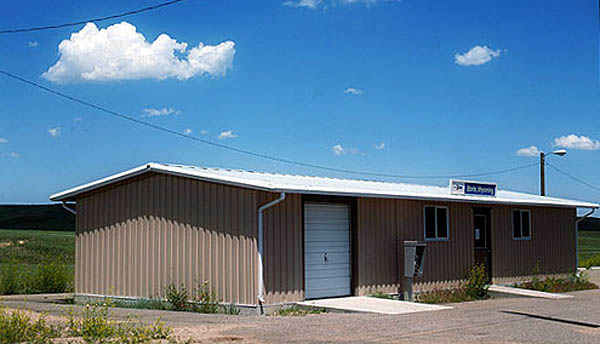
Borie, Wyoming, Amtrak Depot, 1982.
Borie was named after an early dispatcher, Andy Borie. He later rose in the ranks, but perhaps to remind him of his early humble beginnings, the siding continued to bear his name. It was basically a siding at the foot of the
incline up Sherman Hill. In 1893, the Commission of Railroads in a repot to the Secretary of the Interior, noted that Borie consisted of .61 miles of siding and a section house.
Laer it was the scene of two railway accidents, one in 1908 when the brakes on a freight train could not hold coming down
Sherman Hill and a second in 1950 when the rails coming down the hill were covered in frost and the train coming down the hill
hit speeds of 70 miles an hour. The dispatcher at the Borie Tower called Cheyenne to clear the tracks. It was anticipated that the train would not
stop until it reached Archer Hill to the east of Cheyenne. The runaway train, however, stopped when it collided with another train
at Borie. Borie was the location of the Borie-Carr Cut-Off constructed in 1908 which cut distance for trains going to or from Denver. As a result, it became the location for a Dispatch Tower
(depicted on next page) which
was long gone by the time Amtrak constructed the above depot. After a few short years, the California Zephyr was gone with the breeze, rerouted completely by-passing Cheyenne. The Borie station was razed.
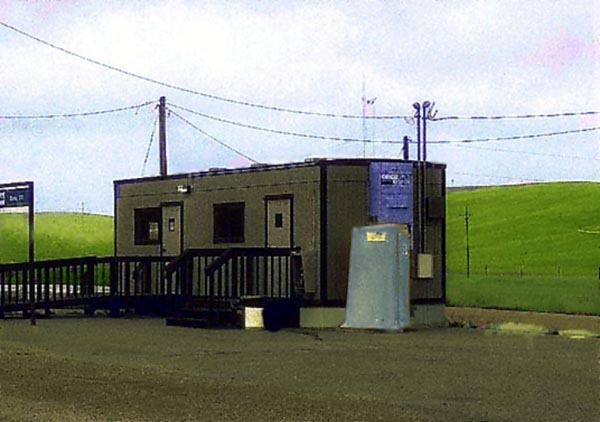
Borie, Wyoming, Amtrak Depot, 1990's.
In the early 1990's,service was resumed with the Pioneer.
As depicted above a second station was constructed. It
was even smaller that the previous station. The pay phone on the outside wall of the earlier station was not replaced, but the restroom facility consisting of a "port-a-potty" was provided.
Various passengers referred to the station as an "Amshack." The last regularly scheduled train pulled out on
May 10, 1997. The station
is now gone. Only the surviving concrete slab, referred to by one wag as an "Amslab," remains. It reminds one of Horace Smith's, poem:
Ozymandias.
In Egypt's sandy silence, all alone,
Stands a gigantic Leg, which far off throws
The only shadow that the Desart knows:—
"I am great OZYMANDIAS," saith the stone,
"The King of Kings; this mighty City shows
"The wonders of my hand."— The City's gone,—
Nought but the Leg remaining to disclose
The site of this forgotten Babylon.
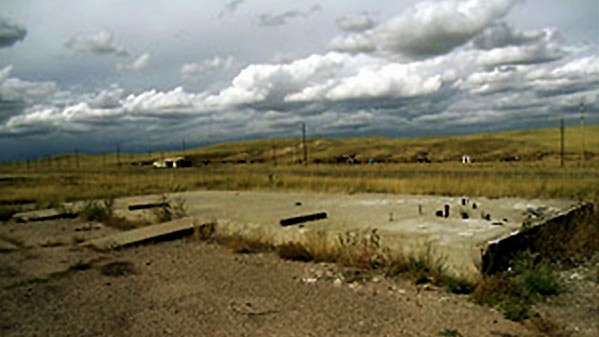
Remains of Amtrak Passenger Station, Borie, Wyoming. Courtesy
wikipedia
Thus, someday, perhaps, a hobo hoping to hop a freignt will note that like in Ozymandias nought but the slab remains to disclose the site of the
last regularly scheduled railway passenger service in Wyoming.
Cheyenne Photos continued on next page.
|